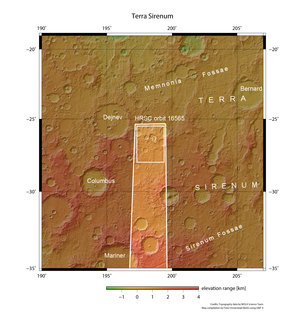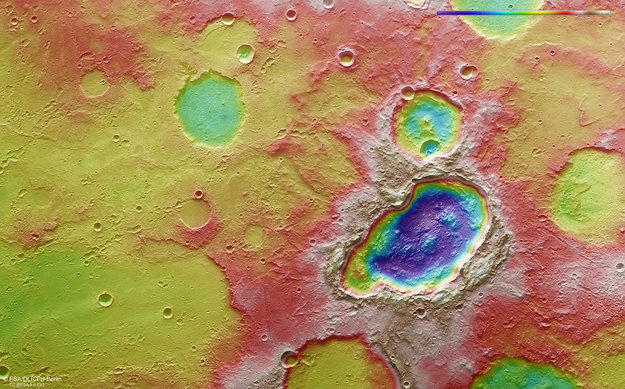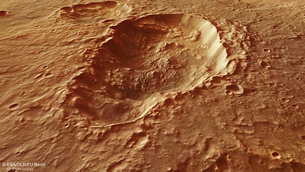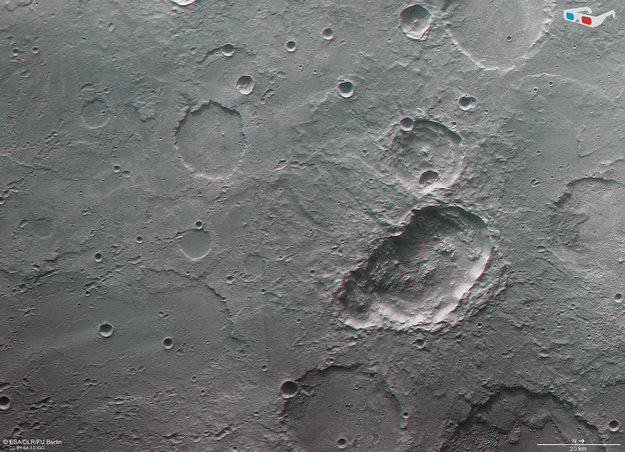Spain
Trío de cráteres
6 abril 2017 A primera vista, parece que esta fotografía no tiene nada de especial, pero el gran cráter alargado muestra la huella del impacto de un objeto que podría haberse partido en tres antes de impactar en Marte.
Las imágenes fueron capturadas el 28 de junio por la sonda Mars Express de la ESA y centran su objetivo en una de las regiones más antiguas del Planeta Rojo, Terra Sirenum, en las tierras altas del sur.
Las imágenes fueron capturadas el 28 de junio por la sonda Mars Express de la ESA y centran su objetivo en una de las regiones más antiguas del Planeta Rojo, Terra Sirenum, en las tierras altas del sur.
La fosa que protagoniza esta escena tiene 45 km de largo y 24 de ancho. Observando su contorno se puede intuir que su huella se debe a la formación de dos cráteres del mismo tamaño y otro menor.
En el fondo del cráter pueden verse dos grupos de material más elevado. Estos picos se generaron en el momento en que se creó la cavidad del cráter inicial, debido a los impactos provocados por la gravedad. El menor de los tres cráteres también deja adivinar un pico central.
Se cree que este tipo de cráteres se formaron al mismo tiempo, pero hay varias hipótesis sobre cómo se llegó a ello. Por ejemplo, es posible que un objeto se partiera en pedazos de menor tamaño al entrar en la atmósfera y que estos golpearan sucesivamente el mismo punto de la superficie marciana.
Otra hipótesis es que el objeto se habría dividido en dos o tres grandes pedazos durante el primer contacto con la superficie, y los nuevos fragmentos se habrían desplazado hacia delante formando el segundo y el tercer cráter.
Una tercera propondría que estos cráteres podrían deberse al impacto de varios componentes fuertemente unidos, un asteroide doble o triple, por ejemplo.
En cualquier caso, como las capas de escombros creadas durante la formación del cráter son continuas y presentan un grosor uniforme a su alrededor, parece evidente que los impactos se produjeron al mismo tiempo.
Además, el material eyectado no se distribuye de forma uniforme alrededor de la cavidad, por lo que se aprecian dos lóbulos opuestos, creando un patrón en forma de mariposa.
Esta formaciónhace pensar que la superficie se vio golpeada desde un ángulo bajo, con el objeto descendiendo de derecha a izquierda, lo que hizo que se acumulara más material eyectado en esa dirección.
El material también alcanzó a los cráteres cercanos, especialmente aquellos en el extremo derecho y en la parte inferior derecha de la imagen principal.
El cráter circular justo más arriba del cráter alargado de esta vista es otro tipo de cráter triple. Los dos cráteres menores —uno en el borde y otro en la base— se formaron en momentos distintos, tal y como determinan los principios de la superposición. Sus contornos están bien definidos, lo que indica que el cráter mayor tuvo tiempo de formarse y asentarse antes de que se produjeran los otros.
La deformación en el borde del cráter interior podría deberse a la formación del cráter alargado.
En esta escena pueden apreciarse otros numerosos ejemplos de cráteres superpuestos, prueba de la gran antigüedad de la región.
Además de arrojar luz sobre la historia de los cráteres, Mars Express y la sonda Mars Reconnaissance Orbiter de la NASA han detectado signos de minerales arcillosos en las capas de material observadas en el interior de los cráteres y en las planicies entre ellos, lo que sugiere la presencia de agua en la zona hace más de 3.700 millones de años.
Para más información:
Oficina de Comunicación de ESAC
Email: comunicacionesac@esa.int
Email: comunicacionesac@esa.int
ENGLISH VERSION :
Crater triplets
6 April 2017
At first glance this scene may seem nothing out of the ordinary, but the large elongated crater marks the imprint of an impacting body that may have broken into three before it hit Mars.
The images were acquired by ESA’s Mars Express on 28 January, and focus on one of the oldest regions on Mars, Terra Sirenum, in the southern highlands.
The elongated trough at centre stage in this scene is 45 km long and 24 km across. Inspection of the outline suggests that two similarly sized craters and one smaller one have merged to create the footprint-like shape.
Two groups of raised material can be seen in the crater floor. These peaks are created as the initial crater cavity produced by the impact collapses under gravity. The smaller crater also has a hint of a central peak.
Craters like these are thought to have formed at the same time, but there are a number of ideas as to how it happened. For example, an object could have broken into smaller pieces after it entered the atmosphere, striking the surface in quick succession in the same place.
Alternatively, it may have shattered into two or three large pieces upon first contact with the surface, the forward motion of the new fragments leading to the second and third craters.
Another idea is that several closely bound components – like a double or triple asteroid – could also result in such craters.
In any case, the fact that the layers of debris thrown out by the event seem to be continuous and at a uniform thickness around the crater further points to the impacts having taken place at the same time.
In addition, the ejected material is unevenly distributed around the cavity, such that there are two dominant lobes of material on opposite sides, creating a so-called ‘butterfly’ ejecta pattern.
This formation suggests that surface was struck at a low angle, with the motion of the object from top right to bottom left leading to more ejecta downrange.
The ejected material has also spilled into neighbouring craters, notably those at the far right and bottom right in the main image.
The circular crater directly above the elongated crater in the main view is a different kind of triple crater. The two smaller craters – one on the rim and one on the floor – formed at different times, as determined by the laws of superposition. Their rims are well defined, showing that the larger crater had time to form and settle before the smaller ones were formed.
The deformed shape of the rim of the innermost crater may be linked to the formation of the elongated crater.
Numerous other examples of overlapping craters can be found in this scene, testament to the old age of the region.
As well as insights into the cratering history, analysis by Mars Express and NASA’s Mars Reconnaissance Orbiter have detected signatures of clay minerals in layered material seen inside craters and on the plains between them, suggesting the presence of water here over 3.7 billion years ago.
Guillermo Gonzalo Sánchez Achutegui
ayabaca@gmail.com
ayabaca@hotmail.com
ayabaca@yahoo.com
Inscríbete en el Foro del blog y participa : A Vuelo De Un Quinde - El Foro!






No hay comentarios:
Publicar un comentario